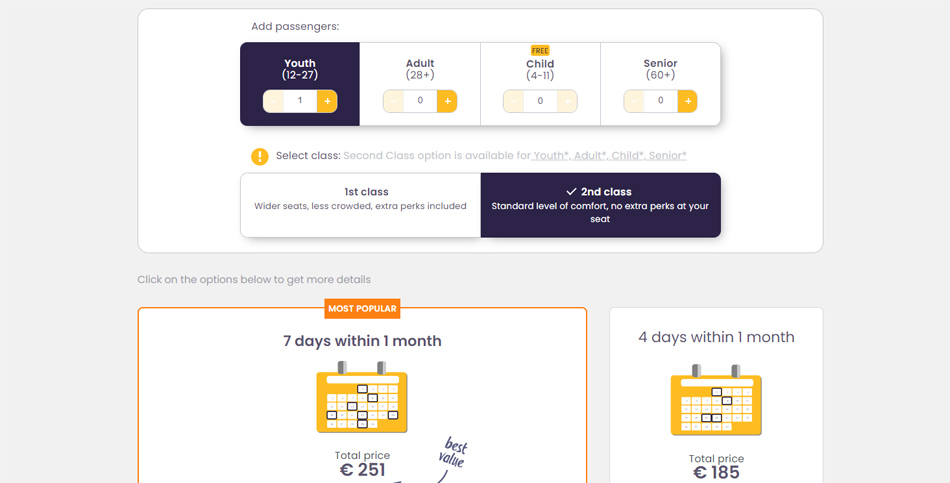Does the idea of traveling extensively through Europe intimidate you? Even though you yearn to explore the countless idyllic European valleys and amazing scenic routes, do you keep pushing your travel plans thinking that continental travel is way beyond your budget as it could cost you a bomb? You have been a European citizen all along and you are already beginning to curse yourself for not exploring even half of this beautiful continent. Well, do not sweat it — take a breather as we let you in on the secret of traveling affordably through multiple countries in Europe — with the ever-so-popular Interrail Global Pass which is meant for all European citizens/permanent residents of Europe.
Train trips are always more in demand than flights for the simple reason that they are cheaper and hassle-free (no security or paid check-ins, or the compulsion to arrive several hours beforehand at the airport); more importantly, they offer ground-level views of stunning landscapes that you otherwise miss on air. What’s more, trains help in cutting down on carbon emissions too. In a nutshell, you have numerous reasons to opt for train journeys, especially in Europe.
What is the Interrail Pass
The Interrail Pass allows you to travel independently and extensively throughout the European continent on dates of your own choosing. It is a ticket that allows unlimited train travel within a given period. But first, let’s break it down to the essentials that you need to bear in mind, plan, and incorporate into your itinerary to make the most of your pass.
Once you have decided to tour Europe exclusively by train, decide which countries or destinations deserve priority listing. The all-in-one Pass allows you to tour 33 countries. The list includes — Austria, Belgium, Bosnia, Bulgaria, Croatia, Czech Republic, Denmark, Estonia, Finland, France, Germany, Greece, Great Britain, Hungary, Ireland, Italy, Latvia, Lithuania, Luxembourg, Montenegro, Netherlands, North Macedonia, Norway, Poland, Portugal, Romania, Serbia, Slovakia, Slovenia, Spain, Sweden, Switzerland, and Turkey.
The Interrail also has attractive discounts for youth under 28 and seniors over 60. There are regular exciting deals also for adults in between; you just need to look up their official website and choose an option that suits your travel plan the best. Children between 4 to 11 years travel for free on a Child Pass, and those under 4 years will need no pass if they are not occupying seats.
You are free to take multiple train rides on a single day, or even out your trips over several consecutive days within the validity period. It’s important to note here that while most European trains are included in Interrail passes, not all are. You can avail of the pass on regional and panoramic trains. Night trains, high-speed ones, and those running popular routes will require you to book seats at additional costs weeks in advance. Seat reservation fares will depend on the train you are choosing to travel by, the travel class (1st or 2nd), and the country you are traveling to. Advance seat booking will also help you to save big.
Interrailing is a sure thing to do when you are considering backpacking for extended periods through Europe. It offers good value for money; it is needless to assert that you will get bang for your buck. There are a variety of travel days to choose from — ranging as little as 4 travel days to even 30 (1 month) or 90 (3 months, which is the maximum period) days of unlimited train travel, as and when you want to. There are more available options, of course, please visit their website to learn more.
How to Get Your Pass

The Interrail pass will cost anywhere between $694 to $772 for those aged between 12 and 27 years for a travel period of 90 days. For the same travel time, it ranges between $926 and $1028 for adults over 27 years. A 30-day Global Pass will, however, cost much less. It is anywhere between $516 and $575 for the youth in the age group of 12 and 27; for adults, it ranges between $687 and $764.
It is a good idea to favor a digital pass over a paper pass because of the convenience. You can always purchase your paper pass at some train stations but a digital pass will save you the sweat and the hassle. It is as simple as ordering the pass online and getting it instantly delivered for free to your registered email id. Once bought, it is valid for up to 11 months. Add your mobile pass to the Rail Planner app before the departure date, activate it, and be raring to go. You will need to add your start date for both types of passes (paper and mobile) before you hop on the train.
When You Want to Contact for Help

If you need to simply access your recent booking or make amends to existing booking, you don’t need to contact the support. You can do the same by signing into your account on the website. For other queries or complaints, write to customerservice@interrail.eu. You can also place a ticket here for assistance.
Note that if passes are unused and have not been activated, they are refundable. You have the option to even deactivate (if it has already been activated) your pass before the validity period if you are dealing with emergencies necessitating trip cancellation. You are not eligible to apply for a refund or exchange or deactivate the pass once the validity period has started.
The amount refunded depends on the price of the pass. If all conditions are met for refunds, then 85% of the money is returned in the original payment mode and a 15% cancellation fee is applied.
There is no refund on partially used, lost, damaged, or stolen passes. Refund requests cannot be submitted later than 6 months from the last day of validity (of the paper pass) or the last possible activation date indicated on the mobile pass.

